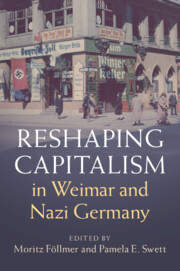Book contents
- Reshaping Capitalism in Weimar and Nazi Germany
- Publications of the German Historical Institute
- Reshaping Capitalism in Weimar and Nazi Germany
- Copyright page
- Contents
- Illustrations
- Contributors
- Acknowledgments
- Introduction Historicizing Capitalism in Germany, 1918–1945
- Part I Debating Capitalism
- Part II Concealing Capitalism
- Part III Promoting Capitalism
- 7 Between Criticism and Innovation
- 8 Managing Consumer Capitalism
- 9 A Society Safe for Capitalism
- Part IV Racializing Capitalism
- Index
9 - A Society Safe for Capitalism
Violent Crowds, Tumult Laws, and the Costs of Doing Business in Germany, 1918–1945
from Part III - Promoting Capitalism
Published online by Cambridge University Press: 20 January 2022
- Reshaping Capitalism in Weimar and Nazi Germany
- Publications of the German Historical Institute
- Reshaping Capitalism in Weimar and Nazi Germany
- Copyright page
- Contents
- Illustrations
- Contributors
- Acknowledgments
- Introduction Historicizing Capitalism in Germany, 1918–1945
- Part I Debating Capitalism
- Part II Concealing Capitalism
- Part III Promoting Capitalism
- 7 Between Criticism and Innovation
- 8 Managing Consumer Capitalism
- 9 A Society Safe for Capitalism
- Part IV Racializing Capitalism
- Index
Summary
Who should pay the costs of civil unrest? Germans confronted this dilemma in the aftermath of the First World War, as thousands of claimants petitioned the government to compensate for varied losses, from stolen crops to medical bills for bullet wounds. By far the greatest demand for redress came from businesses who described “catastrophic” damages caused by looting crowds. To make their case, claimants invoked a seventy-year-old Prussian law that aimed to suppress protest by making the “community” financially liable for “tumult.” And yet the Weimar Republic owed its very existence to the tumult of agitated crowds. This chapter explores how the Weimar Republic and later the Nazi regime staked their legitimacy on their ability to provide sufficient public order to sustain capitalism. But when the costs grew too high, both tried to extricate themselves from liability: the Weimar Republic by citing economic crisis, the Nazi regime by implementing a racial solution.
Keywords
- Type
- Chapter
- Information
- Reshaping Capitalism in Weimar and Nazi Germany , pp. 232 - 254Publisher: Cambridge University PressPrint publication year: 2022

